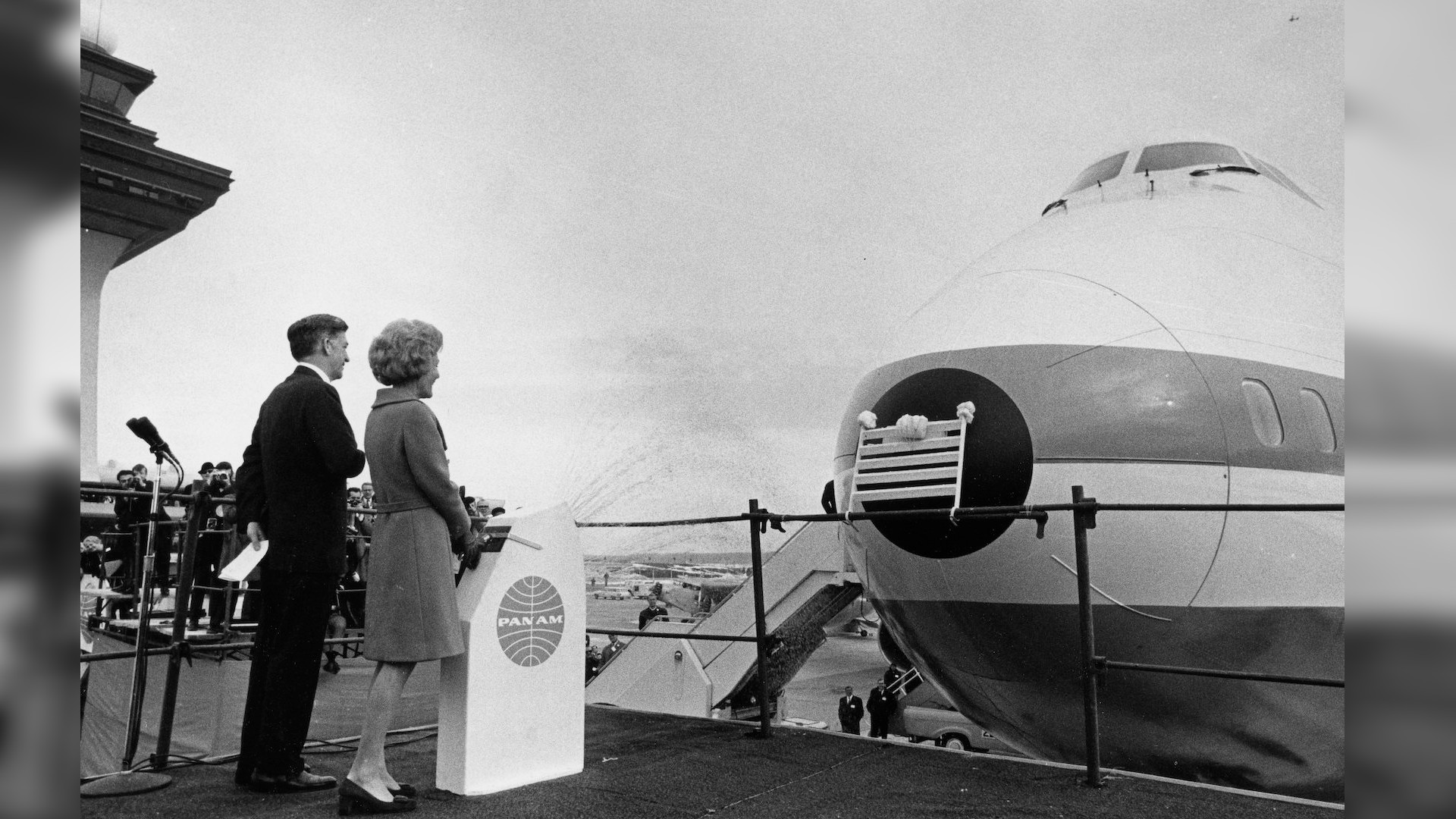Last Boeing 747 rolls out of the factory: How the 'queen of the skies' reigned over air travel

On Sept. 30, 1968, the first Boeing 747 rolled out of its custom-built assembly plant in Everett, Washington. From the beginning, everything about the plane once known as the "queen of the skies" was big.
This article was originally published at The Conversation. The publication contributed the article to Space.com's Expert Voices: Op-Ed & Insights.
On Sept. 30, 1968, the first Boeing 747 rolled out of its custom-built assembly plant in Everett, Washington. From the beginning, everything about the plane once known as the "queen of the skies" was big.
It was the first wide-body "jumbo jet" ever built. About 50,000 construction workers, mechanics, engineers and others took it from an idea to the air in just 16 months in the late 1960s. Until 2007 and the introduction of the Airbus A380, it was the largest civilian airplane in the world.
Versions of the 747 have been used in a variety of famous ways. In 1990, for example, a pair of 747-200s began operating as Air Force One, the plane that ferries around the U.S. president.
Just to produce the 747, Boeing first had to erect what was and still is the largest building by volume ever constructed – big enough to hold 75 football fields or all of Disneyland.
But on Jan. 31, 2023, the last 747 that Boeing expects to build rolled out of its factory.
I've been researching and teaching the history of American aviation for more than a quarter-century. Even though all U.S. airlines have retired their 747s, marking the end of an era, I believe it's worth remembering the amazing story of the airplane that helped make international air travel affordable.
Breaking space news, the latest updates on rocket launches, skywatching events and more!
The jumbo jet is born
The story of the 747, like those of many other aircraft, began with a military request. In 1963, the U.S. Air Force issued a proposal for a very large transport aircraft to carry heavier loads and have a longer range than then-existing transport aircraft such as the C-141.
Although Boeing lost its bid for what is now known as the C5 Galaxy, the designs and studies that went into its proposal didn't go to waste. That's because around the same time, Juan Trippe, the hard-charging president of Pan American World Airways, wanted Boeing to build an airliner twice the size of the first-generation jet airliner, the 707.
It would be "a great weapon for peace, competing with intercontinental ballistic missiles for mankind's destiny," he insisted.
A big risk
But at the time, it was a very risky endeavor.
Many in the aviation industry – including at Boeing – believed that the future of air travel belonged to the fast, not the large. They envisioned new fleets of supersonic aircraft – such as the Concorde, which began flying in 1976 – that would make the existing subsonic flight obsolete, especially on the long routes the 747 was designed to fly. For comparison, the Concorde could make the trip from London to New York in about three hours, while a flight on a 747 (or any other subsonic commercial airliner) could take eight to 10 hours.
But Boeing plowed ahead with the project anyway. The new plane had its first test flight on Feb. 9, 1969, and debuted to a world audience at the Paris Air Show later that summer. By the end of the year, the Federal Aviation Administration declared it airworthy, and Pan Am took delivery of its first 747 on Jan. 15, 1970.
Although the 747-100 at full capacity promised the airlines cost efficiency, the plane rarely flew that way, with 400 passengers. In part, this was because the 747 had the misfortune of launching during a recession and the first oil crisis, both of which resulted in fewer passengers.
In addition, the project's size itself almost threatened the aerospace company – and its banks – with bankruptcy because the aircraft's development required Boeing to take on US$2 billion in debt, or about $20 billion in today's dollars.
Fortunately for Boeing, it hedged its bets by designing the aircraft to function both as a passenger airliner and as an air freighter. It was the freighter variant that required the "hump" at the top of the fuselage to hold the cockpit so that the nose section could swing open.
Since then, Boeing has built over 1,500 747s, and about 500 still fly today.
The golden age of flight
The 747 was – and is – probably the most easily recognizable jet airliner. While most people would have a hard time distinguishing between a Boeing 707 and a DC-8 – or pretty much any other pair of jet airliners – the 747's large size and distinctive "hump" at the front make it unmistakable.
It debuted at the end of the so-called golden age of flight, a time when air travel still was seen as glamorous and most airlines catered to an elite clientele. As such, early operators used the upper deck as a passenger lounge for first-class passengers, rather than filling the plane to its full capacity.
In the late 1970s, in an effort to entice more passengers, American Airlines went one step further, turning the lounge into a "piano bar" complete with a Wurlitzer organ and entertainer who led singalongs with the passengers.
Deregulation, however, soon made such glamorous amenities obsolete as airlines focused on cutting costs rather than offering high-end services. And over time, smaller and more efficient long-range twin-engine aircraft like the 777 and 787 diminished the need for a hulking jumbo jet.
Icon of aviation
Despite its problems, the 747 won a coveted place in American popular culture.
It "starred" in two disaster movies – "Airport 1975" and "Airport '77," not to mention several films that involved hijackings, including "Air Force One."
The 747 also gained further fame from certain specialty missions. NASA, for example, used a specially modified 747 to transport the space shuttle between landing and launch sites.
And, of course, a 747 continues to fly around the "leader of the free world" and his entourage. In 2024, the 747-8 will take over the job, with a longer range, slightly higher speed and a higher maximum takeoff weight.
While the 747 that left the factory Jan. 31 may be the last one built, the airplane should still have a long life as a carrier of freight – not to mention ferrying around the American president – which means these icons of aviation will still fly well into the 21st century.
This article is republished from The Conversation under a Creative Commons license. Read the original article.
Follow all of the Expert Voices issues and debates — and become part of the discussion — on Facebook and Twitter. The views expressed are those of the author and do not necessarily reflect the views of the publisher.

Dr. Janet R. Daly Bednarek is a professor and former chair of the Department of History. Before coming to the University of Dayton, she worked for three years as a historian with the United States Air Force at Bolling AFB, the Pentagon, and Wright-Patterson AFB. Since coming to UD in 1992, she has combined her original professional training as an urban historian with her on-the-job training as an aviation historian. She currently works on the history of airports in the United States, examining them as pieces of the urban transportation infrastructure and also looks at the relationship between airports and city planning. She teaches courses in both urban and aviation history.




